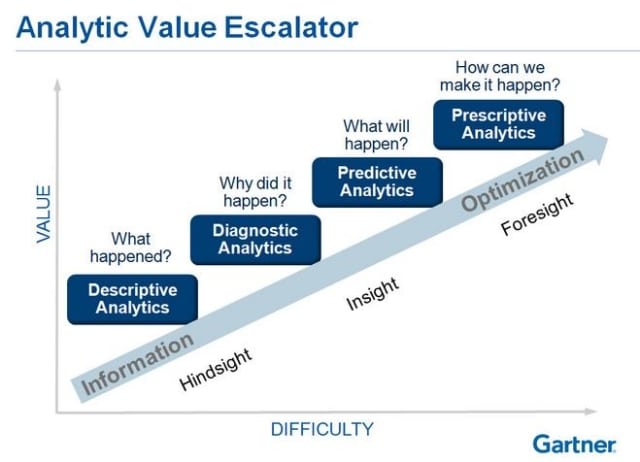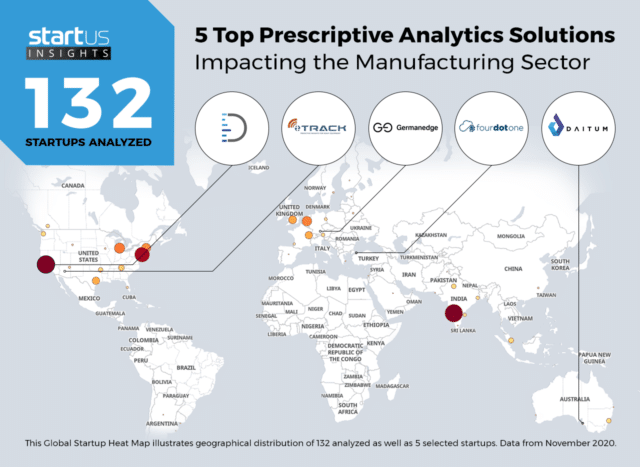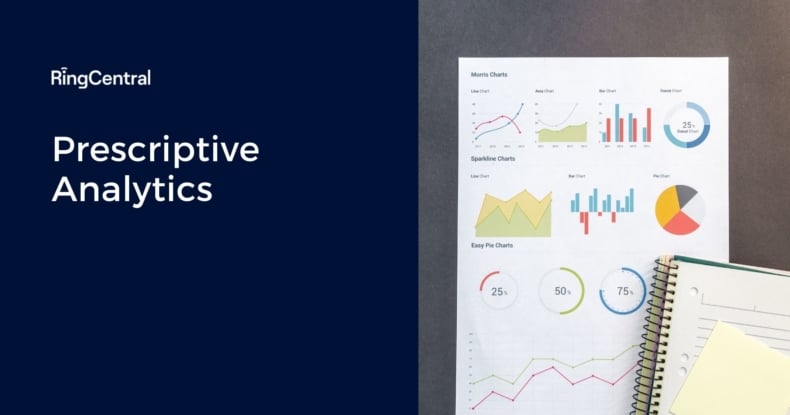In this article, we'll cover:
Prescriptive analytics is a branch of data analytics that applies descriptive analytics and the outcomes of predictive models to suggest actions to take for statistically optimal outcomes.
What is prescriptive analytics?
Closely related to, but distinct from, predictive analytics, prescriptive analytics is used by decision-makers to make data-driven, algorithmically informed choices that factor in possible future scenarios, available resources, past events, performance, and historical trends.
Whereas predictive analytics is the science of forecasting, using statistical models to anticipate likely outcomes based on historical data, prescriptive analytics takes those predictions and uses them to provide actionable insights. Notably recommending the best course of action that minimises risk and maximises possible gains.

How prescriptive analytics works
A typical prescriptive analytics approach is to run a computer simulation of a given scenario over and over again, each time tweaking variables so that the possible outcomes of different paths can be compared. The outcome of these simulations can then be used to help you make better decisions for your business.
Thanks to the power of modern artificial intelligence and machine learning algorithms, contemporary prescriptive analytics models are able to process huge quantities of data and automatically adjust themselves as new data is input.
Prescriptive analytics relies on optimisation techniques such as linear programming, integer programming, and nonlinear programming. These techniques are applied to a model, which represents the decisions to be made, constraints on the decisions, and an objective for comparing outcomes.
The pros and cons of prescriptive analytics
Used correctly, prescriptive analytics can be an incredibly useful tool for business analysts. But that isn’t to say that its use doesn’t come with some caveats.
Pros
-
- Reduce human error
- Limit uncertainty
- Limit risk
- Increase efficiency of business processes
Cons
-
- Can create a false sense of certainty
- Suggestions based on probability do not always make decisions easier
- Requires good, clean data to work properly
- Only effective if you know what questions to ask
Examples of prescriptive analytics
Supply chain optimisation
In the retail sector, prescriptive analytics techniques are frequently applied to find the most efficient production and distribution levels among a set of factories, warehouses, and sales outlets.
To find optimal supply chain solutions, companies need to collate data on stock and expected demand. The task of prescriptive analysis is to then set up and solve a mixed-integer linear programming problem that incorporates the relevant known and unknown variables.
Route planning
The challenge of planning a route is often framed in terms of what is known in decision mathematics as the travelling salesman problem. In the simplest version of this, the challenge is to find the shortest possible path through a network so that every stop is covered.
Of course, in real-world logistics, route planning problems are rarely ever as simple as a single salesman travelling between cities. Advanced analytics models use machine learning to factor in real-time data such as changes to travel options, times, and costs in order to find the optimal route for a given logistical challenge at any given time.
Customer support
Prescriptive analytics can be applied to the challenge of customer support by helping agents to know which approach is most appropriate for a given customer based on what is known about them.

Customer support operations with a well developed data pipeline will have access to all kinds of information about their customers. Analytics tools can then be used by support agents to turn this information into actionable insights, helping them to know whether to offer deals, and what kind of service will be optimal for their customers.
Insurance risk assessment
The insurance industry has always been ahead of the game when it comes to data analysis and is at the cutting edge of applied prescriptive analytics.
Specialised decision management platforms for the sector incorporate the wealth of data that insurers collect to generate intelligent predictions and assess risk levels.
Healthcare
The burgeoning field of healthcare analytics applies prescriptive models across the clinical, financial, and operational aspects of healthcare provision.

In the age of smart medical devices, digital medical records, and remote health reporting, today’s healthcare providers have access to vast data sets that they are looking to leverage to improve patient care and achieve their business goals.
Prescriptive analytics in healthcare has been used to optimise patient to physician ratios, increase revenue from patient referrals, and increase donor engagement by tracking the effectiveness of outreach campaigns.
Production planning for manufacturing
Today’s manufacturers operate in a dynamic environment characterised by complexity and uncertainty. Their financial performance hinges on their ability to manage production costs efficiently, while rapidly adapting to changes in supply and demand.
To maximise profit, manufacturers must be able to determine how much of each product to produce, when to produce it, and in which location.
Demand can fluctuate significantly due to the requirements of different stakeholders, seasonal trends, and other factors. Factories have limited production resources, so manufacturers must consider all the different constraints to optimise the use of available equipment and personnel.
Many leading manufacturers rely on data science and decision optimisation solutions to discover and reduce bottlenecks, respond to demand forecasts, and find the most profitable ways to make use of their facilities, employees, and raw materials.

The cloud and the future of prescriptive analytics
To make the most of their data, businesses are increasingly investing in cloud storage and software solutions. Cloud storage streamlines data management and makes remote access to data easy for the right people, while securing it against abuse by the wrong people.
Getting set up with a cloud data warehouse makes advanced business analytics possible from anywhere. But it also makes the usage of data while adhering to strict business rules incredibly user-friendly.

With the ability to house information while also integrating with an endless range of third party applications, cloud data warehouses give users an all-in-one data analytics solution without the need to maintain expensive and cumbersome servers.
Thankfully, most of the big analytics software platforms can be integrated with the main cloud service providers, making cloud-based analytics even more appealing.
Going forward, prescriptive analytics will have a bigger role to play in making business decisions for more and more companies.
A key trend to watch is the growth of automation in analytics. Increasingly, the actions and decisions prescribed by AI and machine learning are being carried out without any human intervention. For example, it has become the norm in the automotive fuel market for companies to automatically adjust their pricing throughout the day in a way that maximises their bottom line.
The big decisions about a business’s direction are unlikely to be made by AI anytime soon. Moreover, it would be reckless to fully relinquish human responsibility for oversight when it comes to decisions that have complex ethical dimensions.
Nonetheless, data scientists are constantly improving the automation of prescriptive models, suggesting a future in which the insights of Big Data analytics are automatically applied to business processes of all kinds.
How can your business use prescriptive analytics?
Prescriptive analytics isn’t just for high-tech businesses. And neither should you worry that your company doesn’t have enough data to make it worthwhile. If you do any business online, the chances are you already have more data than you think, and with a few changes to your digital infrastructure, you could probably be collecting even more.
If you think your business should be utilising prescriptive analytics techniques, the good news is that these days many business intelligence tools have built-in prescriptive capabilities. All you have to do is apply them.
There are also more niche and industry-specific analytics platforms designed with specific business challenges in mind.
Data-focused operations
Make sure you’re gathering performance data and usage metrics at each stage of your logistical operations so that your analytics efforts have the information available to prescribe optimal changes and solutions.
Where possible, automate data mining by installing sensors and making it as easy as possible for employees to keep systems updated with scheduling and task progress information.
With the right data streams set up, you can easily incorporate prescriptive analytics into your project management toolkit. Use compatible software and have someone responsible for integrating the system as a whole, so that you don’t end up with friction between different systems that might cause bottlenecks and delays.
Prescriptive analytics for contact centres
Any business that runs some kind of customer support or outreach service can apply prescriptive analytics in their contact centres to improve the customer experience. With cloud-based communications platforms like RingCentral, this is true even for virtual contact centres

Machine learning and advanced data analysis can be used to evaluate behavioural patterns in customer data. Use these patterns to prescribe optimal paths for contact centre operatives based upon the statistical likelihood of sales, conversion, retention, conversion, or whatever your centre’s target metric might be.
Sales and marketing
Thanks in large part to the widespread application of Google Analytics, using some form of prescriptive model to enhance decision-making has become the industry standard for ecommerce marketers.
Even for businesses that only make a fraction of their sales online, that fraction is unlikely to get any smaller, making it worth investing in comprehensive analytics solutions today.
The first step is to collect data from your sales platforms, social media, and other avenues of digital engagement. With this data, you will then be able to use prescriptive models to inform your marketing strategy and create personalised, targeted ads for individual users.
Analytics tools will be able to tell you how statistically likely a lead is to convert, whether it is worth targeting them, and which approach is best suited for each customer.
Getting started with prescriptive analytics
To incorporate prescriptive analytics into your business processes, ensure you have a data savvy business intelligence team and that they are well acquainted with your company’s operations and IT infrastructures.
Strong data management skills are essential for business analysts these days, and making sure your data sources and storage are organised and ready for processing is the first step towards implementing an effective prescriptive analytics programme.

Modern analytics platforms tend to combine predictive and prescriptive functionalities, and it’s unlikely that you’ll be carrying out one without the other. IBM, Gartner, Amazon Web Services, and SAS offer some of the most popular data tools which are designed to help a business thrive in today’s interconnected data ecosystem.
Remember to use the analytics tools already built into the systems you currently use, such as your VoIP, web hosting, and cloud storage services. When mobilising new analytics technologies, spend time integrating them fully with your pre-existing technology stack so that you don’t encounter problems with unusable data and inter-platform friction further down the line.
For a data solution designed specifically for customer support, try RingCentral’s reporting and analytics tools today.
Originally published Sep 10, 2021

